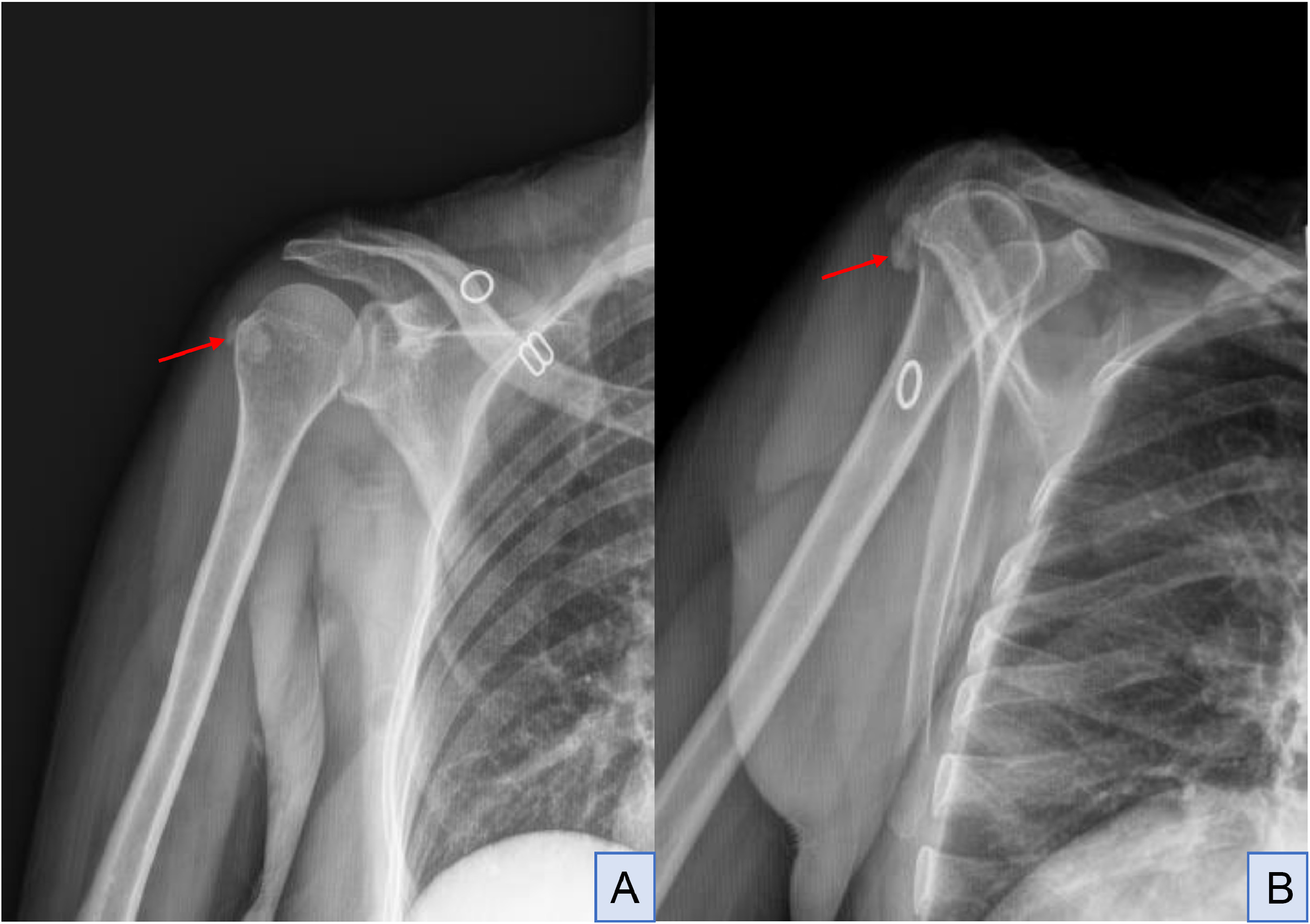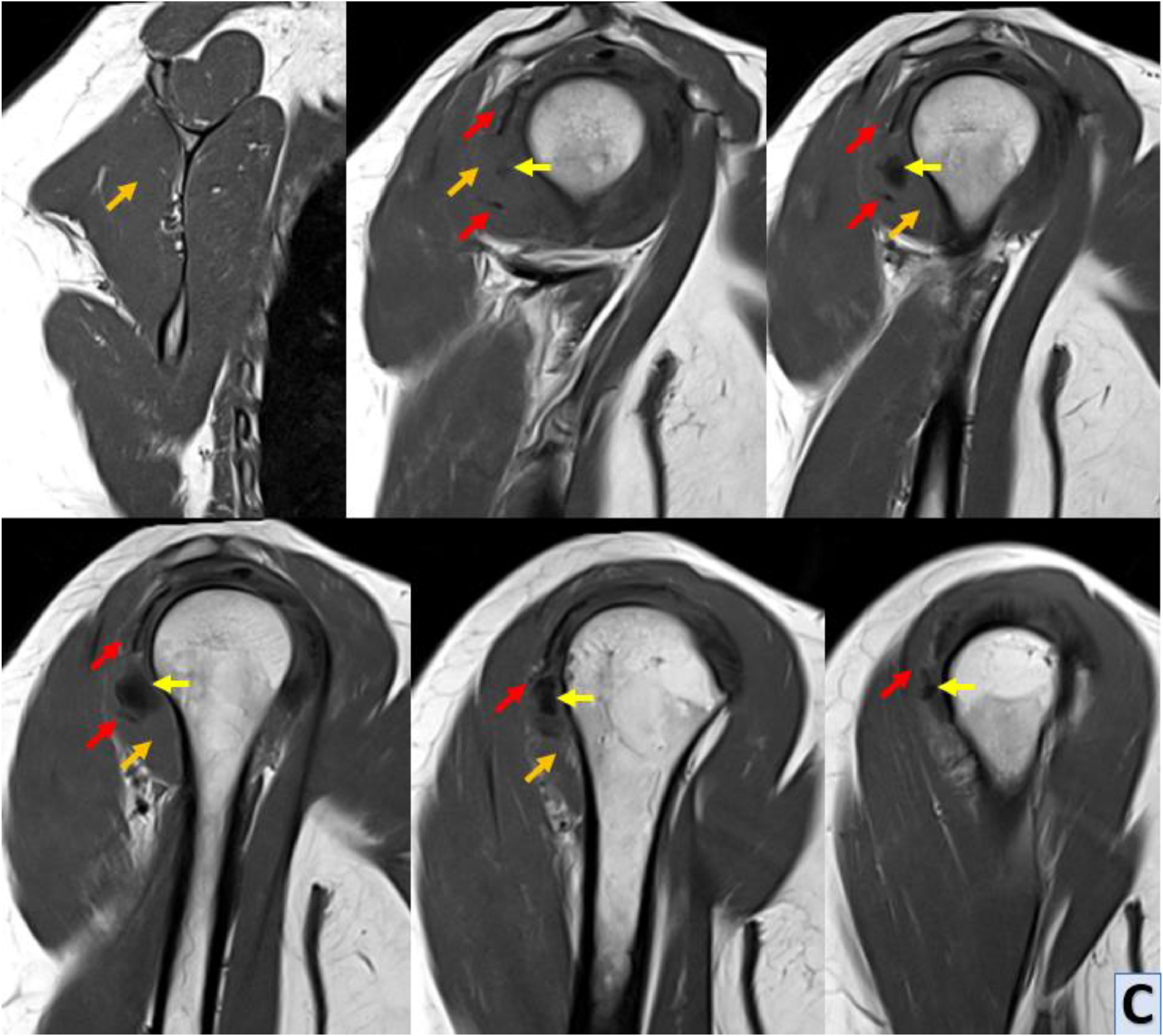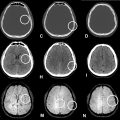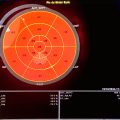Abstract
Calcific tendinopathy is a common disorder associated with the deposition of calcium hydroxyapatite crystals within tendons. The most prevalent location is the shoulder, where it affects the tendons of the rotator cuff. The calcific phase of this condition can be divided into formative, resting, and resorptive stages. During the resorptive stage, phagocytosis of the calcific deposits may occasionally result in their extrusion. These calcifications may migrate within the tendons or into adjacent tissues, leading to local inflammation and intense pain. Intramuscular migration of calcifications, as seen in this case, is particularly rare and poses significant diagnostic challenges. It is associated with increased pain and functional limitation compared to typical cases of calcific tendinopathy. Recognizing the imaging characteristics of these uncommon complications can help prevent the need for additional unnecessary investigations and facilitate prompt intervention. In this article, we present a case involving intramuscular migration of calcifications into the infraspinatus muscle, a rare complication of calcific tendinopathy. This case involves a 55-year-old patient who was dealing with persistent and debilitating shoulder pain.
Introduction
Calcific tendinopathy, also known as hydroxyapatite crystal deposition disease, is a condition marked by the accumulation of calcium hydroxyapatite crystals within tendons. It predominantly affects the rotator cuff, with the supraspinatus being the most frequently affected tendon (80%), followed by the infraspinatus (15%) and subscapularis (5%). Nevertheless, it can also impact sites beyond the shoulder.
Rarely, these calcifications may relocate within the shoulder. Typically, calcifications migrate to the sub-bursal space or inside the subacromion-subdeltoid bursa. Less commonly, calcifications may move to bones or muscles. Intramuscular migration, in particular, is an unusual and underreported complication that can significantly alter the clinical presentation and management of calcific tendinopathy.
The exact etiology of calcific tendinopathy remains elusive; however, several factors have been implicated. These include low oxygen levels within the tendon, hormonal influences (particularly in premenopausal women), and mechanical stresses.
The pathophysiology of calcific tendinopathy involves distinct stages, including precalcific, calcific, and postcalcific phases. During the resorptive phase, calcifications may migrate to neighboring tissues, as observed in our case. This phase, which is often associated with severe pain, can result in complications such as intramuscular migration, which heightens both diagnostic and therapeutic challenges.
Clinically, calcifying tendinopathy may exhibit no symptoms, but it can sometimes lead to pain and mechanical issues, with the resorptive phase often being the most painful. Diagnosis typically involves radiography to reveal the extent, shape, and contour of the calcification. Ultrasound is also a highly effective imaging method for assessing calcifying tendinopathy, offering a detailed view of calcifications within appendicular tendons and accurate monitoring of different stages.
Other imaging tools like CT and MRI are generally unnecessary unless osseous or muscular involvement is suspected. MRI is especially valuable for evaluating bone and muscular edema. In cases of intramuscular migration, MRI is pivotal in distinguishing between tendon-based and muscle-based complications, providing detailed anatomical insights.
Various treatments for Calcific tendinopathy are available, favoring conservative approaches initially, including rest, nonsteroidal anti-inflammatory drugs, physical therapy, and corticosteroid subacromial infiltrations in later stages. Surgery is considered only if conservative treatments prove ineffective. However, in rare cases of intramuscular migration, the severity of pain and the functional limitation may prompt earlier consideration of surgical intervention.
Case presentation
Our patient is a 55-year-old woman, that consulted with complaints of persistent shoulder pain in her right shoulder. She reported that the pain had been worsening over the past few months limiting her ability to perform daily activities. Ms D.Z denied any history of trauma to the shoulder, she noted that the pain seemed to be exacerbated with certain movements such as reaching overhead or lifting objects.
The patient described the pain as an ache that radiated from the top of her shoulder down to her upper arm. She also reported occasional episodes of sharp stabbing pain during certain movements. this pain sometimes interfered with her ability to perform tasks that required overhead reaching or lifting.
Physical examination showed tenderness over the supraspinatus and infraspinatus tendon insertions. Active and passive range of motion of the right shoulder was limited, especially in abduction and external rotation. The patient exhibited signs of muscle weakness and atrophy of the right shoulder.
The radiograph of the right shoulder reveals evidence of calcific tendinopathy in the infraspinatus tendon; it showed irregular calcifications within the soft tissues adjacent to the greater tuberosity of the humerus corresponding to the expected location of the infraspinatus tendon insertion. they appear as radiopaque densities with well-defined margins. No evidence of bony erosion or cortical irregularities is appreciated ( Fig. A ).

The presence of calcifications in the soft tissues surrounding the greater tuberosity suggests an active phase of the disease process, needing further evaluation with ultrasound and MRI to assess for associated inflammatory changes and intra-muscular migration of calcifications.
Ultrasound (US): The ultrasound examination revealed evidence of calcific tendinopathy in the infraspinatus tendon characterized by hyperechoic foci with acoustic shadowing ( Fig. B ).

Dynamic scanning during shoulder movement demonstrated incomplete gliding of the infraspinatus tendon caused by the calcifications, there was also evidence of an inflammatory flare-up with increased vascularity and localized edema within the infraspinatus muscle belly extending distally towards the teres minor muscle.
MRI of the right shoulder confirmed the presence of calcific tendinopathy in the infraspinatus tendon, with multiple calcifications measuring up to 15 mm for the largest one. This calcification had migrated distally into the belly of the infraspinatus muscle resulting in significant edema and inflammation. The edema was characterized by moderate T2 hyperintensity extending towards the teres minor muscle. This was indicative of an acute exacerbation of calcific tendinopathy, MRI also revealed evidence of nonfissured tendinopathy in the subscapularis tendon, characterized by tendon thickening and signal abnormalities consistent with chronic degenerative changes. Additionally, a minimal joint effusion was observed in the glenohumeral joint, suggestive of mild synovitis or joint irritation ( Fig. C-D-E ).











